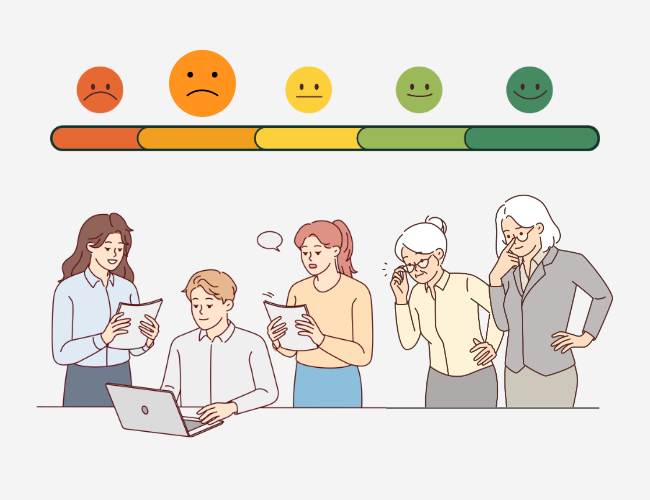With the new year on the horizon, employers are eager to learn about upcoming workplace trends so they can stay ahead of their competition. Changes in employee engagement and experience, workplace arrangements, and employee well-being will be significant factors for the health of any organization.
This article explores nine predictions for the workplace in 2023 that will shape how businesses are run and how employees are engaged. Examine several factors impacting the workplace in 2023 such as employee retention strategies, flexible work arrangements, and tailored benefits.
Employee Engagement & Experience
1. Companies will prioritize employee retention over talent acquisition
As the economic landscape continues to evolve, companies will start prioritizing employee retention over talent acquisition in an effort to reduce costs and increase the effectiveness of their workforce. In 2023, this shift will become even more pronounced as businesses become increasingly aware of how costly replacing employees can be, with US employers spending $2.9M per day searching for replacement workers.
One report revealed that 84% of HR teams are investing more in employee retention than they did in previous years, and 61% of HR directors are prioritizing it over hiring new employees.
2. Employers will invest resources and effort into enhancing employee experience
With the recent rise of “quiet quitters” in backlash to hustle culture, companies will shift their focus towards improving employee experience through engagement initiatives. The discipline towards employee experience will mirror the evolution of customer experience, which went through a revolution in the 2000s as organizations began to use the power of data to align customer preferences and personalize interactions. The growth trajectory for employee experience is likely to be much steeper than customer experience.
Employee engagement, the emotional connection an employee has to a company, is an integral factor of employee experience and the key to retention. One strategy to increase engagement is to operationalize employee recognition. Research shows that employees who are shown appreciation for their work are four times more likely to be engaged. With 85% of employees being unengaged in the workplace, there is tremendous room for growth in 2023 for companies to heighten employee experience and retain their workforce. The role of an employee experience manager will become increasingly common and important to the organization’s growth.
3. Employees expect pay transparency and legislation will back them up
A foundation of trust between employers and employees is crucial. Workers are more likely to become disengaged or leave if there is a lack of transparency, beginning with salary. Job seekers demand that employers be direct about pay ranges, and some legislation has been passed to support this. As of November 1, 2022, a new law in New York City requires employers to state the salary range for an open role, promotion, or transfer opportunity.
In 2023, employers should consider applying pay transparency regardless of legislation. This idea of transparency can be implemented in other aspects of the workplace as employees are looking for value alignment and sufficient information to make the best decisions for themselves. HR professionals will aim to find a balance between transparency and nondisclosure in the coming year.
4. Gen Zers will change the workplace scene
As more baby boomers retire and Gen Xers move up the organizational ladder, Gen Zers will enter the professional world with a fresh outlook. They rely less on extrinsic motivations, like money, and are fueled by intrinsic motivations instead, like whether their job has a purpose and positively impacts their well-being. In fact, 71% of Gen Zers would accept a pay cut in order to do more meaningful work.
Organizations must be aware of generational differences and take necessary actions that appeal to unique age groups.
Workplace Arrangements
5. Employers who want employees to return to in-person work will be met with push-back
After two years of remote work, almost 50% of companies plan to require (or already require) employees to return to the in-office approach full-time next year. These employers believe that employees tend to be more productive in person.
However, 81% of employees who worked from home during the pandemic do not want to go back to the office or want to follow a hybrid model. In the new year, employers who refuse to accommodate their workplace policies to employees’ wants and needs will likely face confrontation, backlash, and turnover.
6. More organizations will implement a four-day work week policy
As the professional world advances, organizations have increased their focus on flexible working arrangements, such as hybrid or remote models. 2023 could be the year employers forego the long-standing convention of a five-day work week. By the midpoint of an ongoing UK study, it was revealed that 86% of companies taking part in a four-day work week trial were ‘extremely likely’ or ‘likely’ to adopt a four-day work week model permanently moving forward. Companies across the US, Scotland, Ireland, Canada, Australia, and New Zealand are following these trends and beginning similar trials, where some are already seeing success. Employees are expected to maintain the same workload as they did while working five days, but non-productive activities would be eliminated from the workday.
Overworked employees are at risk for burnout. By reducing the weekly working hours, organizations can not only maintain a productive and motivated workforce but also improve employee job satisfaction and well-being. It also provides additional time for parents who have caregiving responsibilities outside of work. Provisions for flexible hours will continue being implemented to accommodate caregiving and opportunities unrelated to work.
7. A tight labor market and inflation will fuel unexpectedly higher salary growth
While economic instability due to inflationary pressures will cause budget uncertainty, salary projections are expected to increase in 2023. This is primarily due to the challenges organizations face while finding new workers and their commitment to retaining current employees. In one survey, 57% of employers reported that they have hired candidates higher than the usual salary range, and 76% have adjusted salary ranges more extensively, increasing ranges by 2-5%.
Although salary ranges are expected to grow, organizations may adjust total compensation packages in other ways. Accounting giant EY, for example, recently announced that employees will not be receiving holiday bonuses this year due to the poor economic climate.
While signing and “staying” bonuses are attractive financial compensation measures, there are other options companies can implement. These include offering more flexibility in hours, paid time off, and personalized health and wellness benefits.
Employee Wellness & Benefits
8. Companies will continue investing in employee well-being, especially mental wellness
The focus on employee well-being is at an all-time high. Companies are increasingly taking proactive steps to ensure their employees’ mental wellness, recognizing that it plays a major role in ensuring employee productivity, satisfaction, and retention.
Companies spent $51 billion on employee wellness in 2020, and that number is expected to rise to $100 billion by 2030. In 2022, the most popular solutions were employee assistance programs, digital health tools, and educational resources. Investing in employee mental health through wellness programs not only benefits both the organization and its employees, but also enhances the organization’s appeal to job seekers.
9. Companies will take a hyper-personalized approach to individual needs
In 2023, employers will provide more voluntary benefits to employees that address unique circumstances for a personalized wellness experience. Benefits must appeal to a diverse workforce based on generational differences between Gen X, Gen Z, baby boomers, and millennials. Social determinants of health must also be considered, including environmental, economic, and social conditions that affect an employee’s well-being.
As technology progresses, companies are better equipped to enhance workforce solutions by personalizing them to individual employees. Sixty-eight percent of executives claim that their future workforce strategies will be more customized to individual needs, and this becomes increasingly attainable with machine learning. There will likely be an exponential rise in the use of machine learning and other forms of artificial intelligence for both business endeavors and employee wellness measures.












